KLS, VISHWANATHRAO DESHPANDE INSTITUTE OF TECHNOLOGY, HALIYAL

Therapeutic Uses
Benefits of Kachnar as Anti-diabetic:
- Kachnar was found to reduce the elevated blood sugar levelwhen its hydroalcoholic and alcoholic extract was given to rats.
- Kachnar contains a domain structure with the same amino acid sequence as insulin.
Benefits of Kachnar as Anti-inflammatory and Analgesic:
- Kachnar was reported to show anti-inflammatory and analgesic activity.
- It was found to have a new triterpene saponin (compound 9) in its leaves that decreases oedema, followed by a significant decrease in prostaglandin E2 (PGE2) levels in granuloma, liver homogenate, and serum.
- In addition, the decrease in the diameter of pulmonary and hepatic granuloma was found after treatment with the compound, which can be due to its anti-inflammatory activity.
- It also shows analgesic effects in central and visceral nociceptive mouse models.
Benefits of Kachnar Due to its Anticarcinogenic Activity:
The methanolic extract of the stem bark of kachnar was reported to exhibit anticarcinogenic activity in the mice model.
Benefits of Kachnar Due to Haemagglutinating Activity:
The protein obtained from the crude seeds of kachnar has haemagglutinating activity and is used for detecting the presence of viral particles.
Benefits of Kachnar as an Antioxidant:
- The ethanolic and water extracts of kachnar have shown significant antioxidant activity.[5]
- The presence of phytoconstituents in kachnar like β-sitosterol and oleic acid have been known to decrease hyperlipidaemic states.[2]
Benefits of Kachnar due to Hypolipidaemic Activity:
- The aqueous and ethanolic extracts of the root and stem bark of kachnar effectively decreased the lipoprotein and plasma lipids levels in a rat model.
- It lowered low-density lipoprotein (LDL), very-low-density lipoprotein (VLDL), cholesterol, and triglyceride and increased high-density lipoprotein (HDL) levels.
Benefits of Kachnar Due to Immunomodulatory Activity:
The ethanolic extract of the stem bark of kachnar exhibits immunomodulatory activity on the primary and secondary antibody response by humoral antibody response for particular immune responses.
Benefits of Kachnar Due to Anti-tumour Activity:
The aqueous and ethanolic extract of the stem of the kachnar has shown antitumour activity in the mice model.
Benefits of Kachnar as Nephroprotective Activity:
The ethanolic extract of the stem of kachnar was given to rats, which attenuated various biochemical and histological symptoms of cisplatin nephrotoxicity; this resulted in decreased urea and creatinine serum level and increased body weight and urine output.
Benefits of Kachnar Due to Anti-ulcer Activity:
- The ethanolic extract of the stem of kachnar exhibited anti-ulcer activity.
- It decreased the total and free acidity, the volume of gastric secretion, and ulcer index in the rat model.
Benefits of Kachnar as Neural Activity:
Kachnar has neural activity. The inhibition of acetylcholinesterase activity was found through thin layer chromatography (TLC). The inhibition of enzymes was mainly observed in flowers.
Benefits of Kachnar as an Anti-microbial Agent:
- The leaf extract of kachnar was found to inhibit bacterial growth. Its anti-microbial spectrum is relatively narrow. Sensitive organisms are Pseudomonas species, E. coli, Klebsiella pneumonia. The polar extract was effective against these bacteria.
- The bark powder of kachnar shows bio-enhancing, anti-bacterial, anti-inflammatory properties.
Benefits of Kachnar as Haematinic Activity:
The aqueous and ethanolic extract of the stem bark of kachnar increases the haemoglobin content of blood in rats
Other uses
- Kachnar tree has several therapeutic and biological properties, in one or the other form, which include anti-diabetic, anti-inflammatory, immunomodulatory, haematinic (increases the haemoglobin content of blood), anti-microbial, anti-ulcer, anti-tumour, haemagglutinating (clumping of red blood cells), anti-bacterial, and hepatoprotective (prevents damage to the liver) properties.[3]
- Traditionally, kachnar is used in leprosy, bronchitis, liver disorders, bacterial infection, skin disease, dysentery, diarrhoea, intestinal worms, ulcer, wounds, tumours, and fungal infection.
- Infusion of the leaves is used for treating piles and as a laxative.
- The stem bark is used as anti-diabetic, astringent, anti-tumour, tonic and anthelmintic, and for washing ulcers.
- Dried buds are used to treat tumours, dysentery, diarrhoea, worms, and piles.
- The roots of kachnar trees have flavanone glycoside responsible for anti-inflammatory activity
KLS, VISHWANATHRAO DESHPANDE INSTITUTE OF TECHNOLOGY, HALIYAL is proudly powered by WordPress